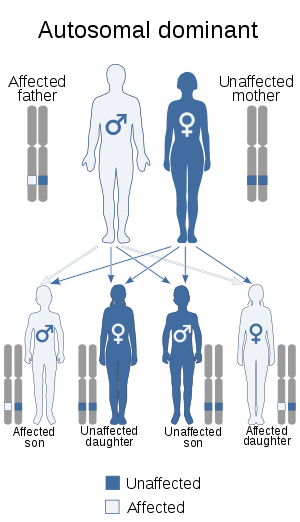Schmid metaphyseal chondrodysplasia
| Schmid metaphyseal chondrodysplasia | |
|---|---|
 | |
| This condition is inherited in ab autosomal dominant manner |
Schmid metaphyseal chondrodysplasia is a type of chondrodysplasia associated with a deficiency of collagen, type X, alpha 1.[1][2][3]
Unlike other "rickets syndromes", affected individuals have normal serum calcium, phosphorus, and urinary amino acid levels. Long bones are short and curved, with widened growth plates and metaphyses.[4]
It is named for the German researcher F. Schmid, who characterized it in 1949.[5]
References
- ↑ Mäkitie O, Susic M, Ward L, Barclay C, Glorieux FH, Cole WG (September 2005). "Schmid type of metaphyseal chondrodysplasia and COL10A1 mutations--findings in 10 patients". Am. J. Med. Genet. A. 137A (3): 241–8. doi:10.1002/ajmg.a.30855. PMID 16088909.
- ↑ Ho MS, Tsang KY, Lo RL, et al. (May 2007). "COL10A1 nonsense and frame-shift mutations have a gain-of-function effect on the growth plate in human and mouse metaphyseal chondrodysplasia type Schmid". Hum. Mol. Genet. 16 (10): 1201–15. doi:10.1093/hmg/ddm067. PMID 17403716.
- ↑ Tan JT, Kremer F, Freddi S, et al. (March 2008). "Competency for nonsense-mediated reduction in collagen X mRNA is specified by the 3' UTR and corresponds to the position of mutations in Schmid metaphyseal chondrodysplasia". Am. J. Hum. Genet. 82 (3): 786–93. doi:10.1016/j.ajhg.2008.01.006. PMC 2427218. PMID 18304492.
- ↑ Benson, Michael. "Children's Orthopaedics and Fractures". Springer. p. 93.
- ↑ Schmid, F. Beitrag zur Dysostosis enchondralis metaphysarea. Mschr. Kinderheilk. 97: 393-397, 1949.
External links
| Classification | |
|---|---|
| External resources |
This article is issued from
Wikipedia.
The text is licensed under Creative Commons - Attribution - Sharealike.
Additional terms may apply for the media files.